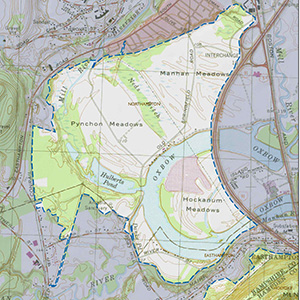Important Bird Area Sites in Massachusetts
Important Bird Area: Arcadia Wildlife Sanctuary and West Meadows
Site Summary
Nominated By
David McLain
Size
750 acres
Towns and Counties
Easthampton, Northampton; Hampshire
Ownership
Municipal, Mass Audubon
Major Habitats
34% palustrine wooded swamp, 26% oak-conifer transitional forest, 20% cultural grassland, 7% cultivated field, 5% emergent freshwater wetland, 5% river/stream
Land Use
Nature & wildlife, conservation, land trust, other recreation, agriculture/livestock, utility/ right-of-way, research, undeveloped
Serious Threats
Non-native, invasive plants, succession, residential, commercial development
Minor Threats
Natural pests/disease,introduced animals, recreation
IBA Criteria
- Category 1: Sites important for long-term research and/or monitoring projects that contribute substantially to ornithology, bird conservation, and/or education.
- Category 4: Sites containing assemblages of species characteristic of a representative, rare, threatened, or unique habitat within the state or region.
- Category 5: Land Birds: The site is an important migratory stopover or seasonal concentration site for migratory land birds (e.g., warblers). Sites may also qualify on the basis of supporting exceptionally high densities of breeding species as shown from point counts or other surveys or if they represent "migrant traps" relative to surrounding areas. Strong consideration will be given to areas with consistently high overall species diversity..
Site Description
Arcadia Wildlife Sanctuary has a diverse array of habitats, as well as an important location. Habitats include exemplary floodplain forest, the Mill River (slow flow, sandy substrate), a large freshwater marsh, buttonbush marshes, an abandoned oxbow, an abandoned Mill River channel, vernal pools, red maple swamps, lowland oak-maple-pine-hemlock forest, old apple orchard, crabapple orchard, shrubby hedgerows, cultural grasslands (including native grassland restoration fields), agricultural fields, and weedy fields. In particular, the Ibis Pool is a depression that holds water in spring and is surrounded by weedy fields, grassland, and shrubby habitats in close proximity to Arcadia Marsh. The depression itself also has wetland plants (knotweed, narrow-leaved cattail, bur-reed, canary-grass).
In addition to the variety of habitats, Arcadia is located in close proximity to the Connecticut River (it abuts the Oxbow of the Connecticut River), the Mount Tom and Mount Holyoke ranges, the East Meadows of Northampton, and large tracts of forest to the west in Northampton and adjacent towns. This location places Arcadia in an important migration route as well as a vital wildlife corridor. Because of the many unusual species recorded in Arcadia Meadows (the West Meadows) and the Ibis Pool, the area is widely known and visited by birders. The crabapple orchard, Arcadia Marsh, and the Mill River with its exemplary floodplain are also significant habitats. The habitats and the geographic proximity to other important areas make Arcadia a valuable location. Six nearby colleges also make the sanctuary a good site for research opportunities.
Current Conservation Status
This site is a Mass Audubon wildlife sanctuary. The major threat is invasive plants, including purple loosestrife, water chestnut, Eurasian milfoil, glossy buckthorn, honeysuckle, barberry, multiflora rose, and bittersweet. While the milfoil is a recent invader, other invasive exotic plants have been actively managed by pulling. The hemlock woolly adelgid is also a recent invader and threatens the integrity of the forest. House Sparrows are pests for nest box species and are controlled to some extent. A natural disease of butternut (canker) is seriously threatening the remaining butternuts on the property. Cowbird eggs have been found in about 33% of Wood Thrush nests, and several other species have been seen feeding young cowbirds. Succession to goldenrod and old-field habitat threatens the productivity of the weedy fields surrounding the Ibis Pool. Tilling and fire have been used to set back succession, with better luck with tilling. Development threatens to cut off the corridor between Mount Tom and Arcadia. Some farmland has been purchased with conservation restrictions. Recreational boating in the Oxbow is frequent.
Ornithological Significance
Consistent nesting site for Cooper's Hawk.
At least ten regional high conservation priority species and three state high conservation priority species breed at Arcadia.
Stopover area for hundreds of waterfowl of several species (marsh/rice).
Significant stopover for numerous fall migrants in weedy fields.
Exemplary floodplain forest; unique combination of grassland, weedy fields, and freshwater marsh; concentration of crabapples.
Breeding bird census plot since 1975; grassland bird census since 1994; Eastern Bluebird research and management; numerous nest boxes. The site has been a breeding bird census plot since 1975. Native grassland restoration has been implemented in several fields, and a grassland bird census has been conducted since 1994, including Eastern Bluebird research and management.
Other Flora or Fauna of Significance
Twenty-four rare fauna and flora species have been identified within the site.
Data Sources
D. McLain personal observations and data.




